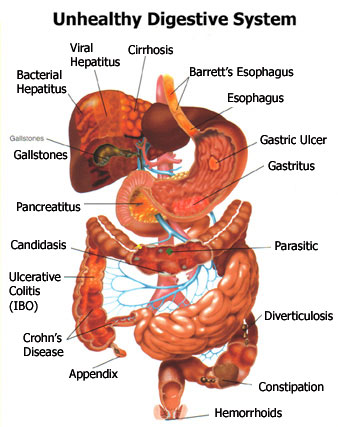Inflammatory Disorders
Appendicitis is an acute inflammation of the appendix. First symptoms include referred pain in the umbilical region and nausea. Later, pain is localized in the right
lower quadrant of the abdominal wall. Surgical removal of the appendix is the standard treatment.
Inflammatory bowel disease (IBD) is a group of chronic disorders that cause painfully swollen, inflamed intestines, in addition to abdominal cramps and bloody diarrhea. IBDs result from an overactive immune response that continuously promotes inflammation, which causes permanent changes in the intestinal tissues and places sufferers at greater risk for developing intestinal cancer. There is a genetic predisposition for developing IBD. Treatment includes corticosteroids and immunosuppressant drugs. Surgical removal of the affected portions of the intestines is necessary when drug therapy fails to provide remission. The major IBDs are Crohn disease and ulcerative colitis. Crohn disease may affect any portion of the alimentary canal but most often affects the distal portion of the ileum. Ulcerative colitis affects only the large intestine and/or rectum.
Irritable bowel syndrome (IBS) is an intestinal disorder causing abdominal bloating, cramping pain, constipation, and diarrhea. Unlike IBDs, IBS does not permanently damage intestinal tissues, with symptoms usually controlled by dietary and lifestyle changes.
Diverticulitis (di-ver-tik-u-li’-tis) is a disorder of the large intestine. Small, saclike outpockets of the colon often develop from a diet lacking sufficient fiber (bulk). Diverticulitis is the inflammation of these diverticula and may cause considerable pain, bloating, or diarrhea.
Hemorrhoids is a condition in which one or more veins in the anal canal become enlarged and inflamed. Chronic constipation contributes to the development of hemorrhoids.
Hepatitis, an inflammation of the liver, may be caused by several factors, including viruses, drugs, or alcohol. It is characterized by jaundice, fever, and liver enlargement. Hepatitis is the number one reason for liver transplants. There are three common viral types of hepatitis in the US.
Hepatitis A (infectious hepatitis) is caused by the hepatitis A virus, which is spread by sexual contact and fecal contamination of food and water. It is highly contagious, but an effective vaccine and treatment are available. Symptoms are usually mild. Recovery takes four to six weeks.
Hepatitis B (serum hepatitis) is a serious infection. It is spread through contaminated blood, saliva, vaginal secretions, and semen. Most people recover completely, but some retain live viruses for years and unknowingly serve as carriers of the disease. Chronic hepatitis may produce cirrhosis or lead to liver cancer. Hepatitis B vaccine is the best protection against hepatitis B infection. It consists of a series of three spaced injections and may be given to persons of all ages, including infants. Chronic hepatitis B patients are treated with antiviral medications.
Hepatitis C, the most common type of hepatitis in the US, is spread primarily by contaminated blood but also by contaminated food and water. Symptoms are usually so mild a person may not even know he or she has it until liver damage shows up, maybe decades later. It can lead to liver failure, cirrhosis, and cancer. In some cases, the symptoms are mild and short-lived so medications are usually not needed. Most cases progress to the chronic form of the disease and require antiviral medications. There is no Hepatitis C vaccine currently available.
Periodontal disease refers to a variety of conditions characterized by inflamed and bleeding gingivae, in addition to degeneration of the gingivae, cement, periodontal ligaments, and the alveoli which causes loosening of the teeth.
Peritonitis is the acute inflammation of the peritoneum that lines the abdominal cavity and covers abdominal organs. It may result from bacteria entering the peritoneal cavity due to contamination during accidents, surgery or by a ruptured intestine or appendix.
Noninflammatory Disorders
Cirrhosis of the liver is characterized by scarring, which results from dense irregular connective tissue replacing destroyed hepatocytes. It may be caused by hepatitis, alcoholism, nutritional deficiencies, or liver parasites.
Constipation is a condition in which defecation is difficult because feces are harder and drier than normal. This results from feces remaining in the colon for a longer than normal period, which allows more water to be absorbed.
Dental caries-tooth decay-result from the excess acid produced by certain microorganisms that live in the mouth and use food residues for their nutrients. Residues of carbohydrates, especially sugars, nurture these microorganisms and increase their acid production.
Diarrhea is the production of watery feces due to the abnormally rapid movement of chyme through the colon, which decreases the amount of time available to absorb water. Increased peristalsis may result from a number of causes, including inflammation and chronic stress.
Eating disorders result from an obsessive concern about weight control, especially among young adult females. There are two major types of eating disorders: anorexia and bulimia.
Anorexia nervosa is self-imposed starvation that results in malnutrition and associated physiological changes. Patients with this disorder see themselves as overweight, although others see them as very thin. Death can occur due to the complications of prolonged starvation.
Bulimia is characterized by frequent overeating and purging by self-induced vomiting. Fears of being overweight, depression, and stress are associated factors. The exact cause is unknown. Bulimia may lead to such complications as an imbalance of electrolytes, erosion of tooth enamel by stomach acids, and constipation.
Gallstones result from crystallization of cholesterol in bile. They commonly occur in the gallbladder, but they may be carried into the bile duct where they block the flow of bile. Severe pain and often jaundice accompanies such blockage. Treatment may include drugs that dissolve the gallstones, shock-wave therapy to break up the stones, or surgical removal of the gallstones and gallbladder.


 (50 votes, average: 4.74 out of 5)
(50 votes, average: 4.74 out of 5)